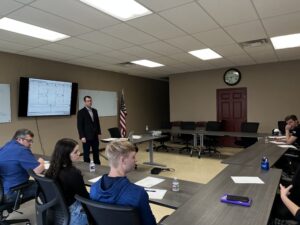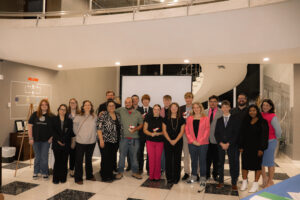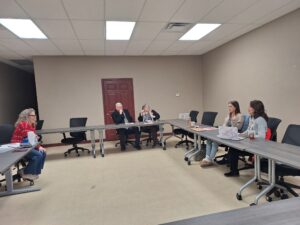
Breaking Down the World Into Data: A Conversation with Vinayak Mitty
November 3, 2023 by Jessika Leatherbury
By: Sunnie Dawn Baker
 When Vinayak Mitty was fifteen, he wanted to help his friend with a birthday surprise for his girlfriend. Mitty took a motor from a moped, added a pulley system and a conveyor belt, and made cakes, balloons, and presents appear from nowhere, like magic. From a young age, Mitty always liked taking machines apart and putting them back together, sometimes in new and novel ways. These skills brought him joy and later brought joy to his friend’s girlfriend when he engineered a beautiful birthday surprise. Mitty loved breaking things down and putting them back together, and this eventually led him to study mechanical engineering. He saw the components and patterns in objects, and this ability eventually led him to a new path: data science.
When Vinayak Mitty was fifteen, he wanted to help his friend with a birthday surprise for his girlfriend. Mitty took a motor from a moped, added a pulley system and a conveyor belt, and made cakes, balloons, and presents appear from nowhere, like magic. From a young age, Mitty always liked taking machines apart and putting them back together, sometimes in new and novel ways. These skills brought him joy and later brought joy to his friend’s girlfriend when he engineered a beautiful birthday surprise. Mitty loved breaking things down and putting them back together, and this eventually led him to study mechanical engineering. He saw the components and patterns in objects, and this ability eventually led him to a new path: data science.
After Mitty received his degree in mechanical engineering, he began his career working in the automotive industry in India. After a couple of years, he moved to Buffalo, NY, to continue his studies. This is where he found a passion for data analytics and statistical modeling. Mitty also started playing around in HTML, and that experience was life changing for him. He says, “It was such a revelation. You didn’t need to invest a lot of money or break expensive items. You could write a piece of code, and magically it appeared as a website. I think that’s when I started transitioning from mechanical engineering to programming.” As Mitty learned more and more as an SAP (Systems, Applications, and Products) Consultant, he realized that data science was where he wanted to be. In 2017, he moved to Ada and began working at LegalShield. He currently holds the position of Director of Data Science and Engineering.
At first glance, mechanical engineering and data science might appear to be very different fields. However, when you think the way Mitty does, it all makes sense. Mitty always liked physics and thinking about things from the First Principles approach, where you start thinking about a problem from scratch as if you are the first person to come across the challenge. He says, “You are building from the ground up. After you have that thought experiment, then you can find things that already exist that can help you solve the problem.” In mechanical engineering, your tools are tangible, physical objects; in data science, the tools are information.
When it comes to working with data, there are three major components: engineering, analytics, and data science, each building upon the previous. Data Engineering brings in data from all different sources, such as data from a website, digital data from social media, or financial data. Data Analytics takes that data and makes sense of it, creating data points in the form of charts and graphs. Data Science uses the information from engineering and analytics to recognize patterns and predict what is going to happen in the future. This is the area where machine learning and AI become major components. Some of this machine learning manifests as fraud detection models, while others predict the demographics of customers and how to serve them better. Instead of taking apart a moped to its base components and rebuilding it into something novel, Mitty now breaks down data and rebuilds it into something that predicts the future. As Mitty says, “You are taking digits and numbers and telling a story with it. Then you use that story to solve a problem.”
The storytelling aspect of data interests Mitty the most. He says, “It is becoming so important for a company to be data-driven. If you don’t look at the data, the story is written for you. But if you are good with data and use that as a tool to achieve your business goals, then you can write the story in many ways. If you don’t look at the data, then it is like your fate is written for you, and you just have to accept it. But the thing I like about data is that I can try to see the future.”
Machine learning and AI play a major role in making sense of data to assist people in telling that story. Computers automate many things that people have already done, but they do it faster and more efficiently. Mitty says, “Our minds already have these pattern recognition systems. We already know that what we call intuition is thinking about these patterns in the past, churning through all the data, and an answer just pops up. AI is doing that with the collective knowledge of humanity.” These systems allow data scientists to process more information, see more patterns, discover more problems, and find more solutions.
Mitty’s love of the First Principles approach to problem-solving makes him acutely aware of the importance of breaking the world down into data so that it can be reformed into something significant and telling. Though he started this journey in the physical world with mechanical engineering, these same principles apply equally to data science with numbers and information, and even management and leadership, assessing the short-term and long-term goals of individuals, units, and the company to find the common ground where all the goals can align.
Mitty sees the importance of data in all aspects of our lives, but especially its essential nature for businesses. There is power in data. It tells a story. It transforms our understanding of reality and gives us a chance to think about the problems of our world in a different way. You can find more of Mitty’s views about data on his blog where he explores how data and AI can be used to solve different business problems. Watch for his upcoming podcast “Data Democracy,” where he will be interviewing business leaders in all different industries to understand a variety of diverse problems and how data can help solve them.
Sign up to receive more news from the Ada Jobs Foundation HERE!
Written by
Jessika Leatherbury
You may also interested in:

BUILDING FUTURES: WORK READY ADA CELEBRATES ITS FIRST YEAR
BY: CATHLENA SPENCER Just one year ago, Work Ready Ada, a new employment readiness program, was launched in partnership with Pontotoc Technology Center (PTC). The program, funded by Oklahoma Human
AI IN EDUCATION: A CONVERSATION WITH VINAYAK MITTY
BY: SUNNIE DAWN BAKER One of the areas in technology with the most potential for entrepreneurial growth is Artificial Intelligence (AI). AI is increasingly shaping every part of our lives,
Adapt and Overcome: Allison Poe’s Recipe for Resilience and Growth
By: Sunnie Dawn Baker Allison Poe has always followed her feet. She waits for the signs to appear and, once she recognizes them, she travels that path, and has never
Jeff Warren: A Life in Sound, Vision, and Storytelling
By: Sunnie Dawn Baker When Jeff Warren got involved in the Houston music scene as a teenager, he had no clue where his path would lead. Now, nearly thirty years
From Pitch to Progress: ECU's Glass Recycling Program Turns Waste into Opportunity
By: Sunnie Dawn Baker In 2018, Dr. Christine Pappas competed in Ada Jobs Foundation’s Big Pitch Competition by promoting grinding glass bottles into sand. She won the Big Pitch that
The Importance of Customer Discovery: Know Your Audience and Know Your Market
By: Sunnie Dawn Baker Entrepreneurs and small business owners must consider many factors to achieve success, with their target market being one of the most crucial. Sometimes, when people are
What Does Economic Development Do for You? The Significance of the Economic Multiplier
By: Sunnie Dawn Baker People often find the term “economic development” vague and confusing. Understanding how economic development works and benefits the community can be challenging. Though there are many
Helping Entrepreneurs One Workshop at a Time: Lauri Rowe and QuickBooks for Small Businesses
Entrepreneurs tend to be filled with passion and big ideas. They have found a solution to a problem they see in the world, and they barrel ahead, excited for their
Hunter Cook: Technology, Entrepreneurship, and the Written Word
By: Sunnie Dawn Baker Hunter Cook started writing when he was seven years old. At first, he wanted to write comic books, but then he realized he couldn’t draw. He